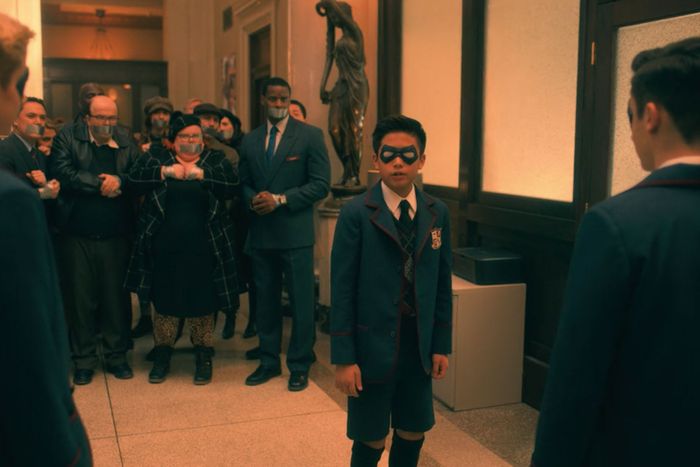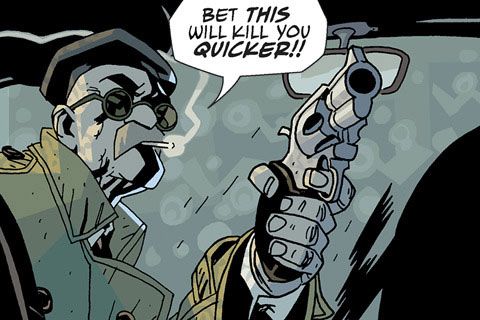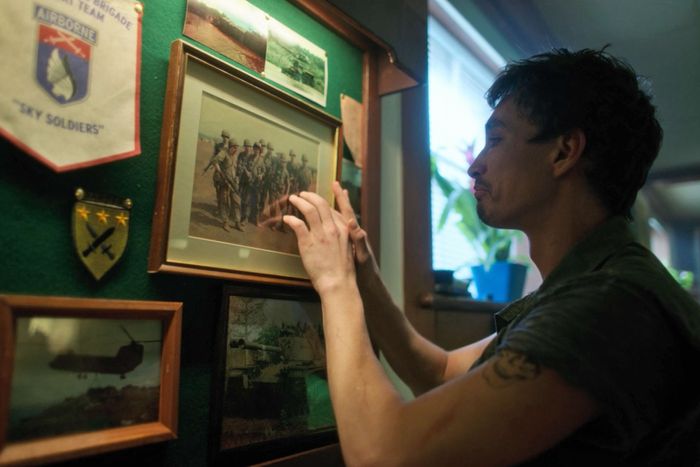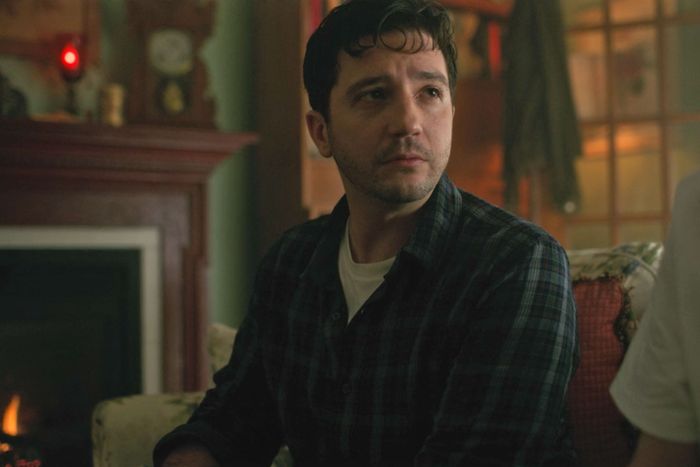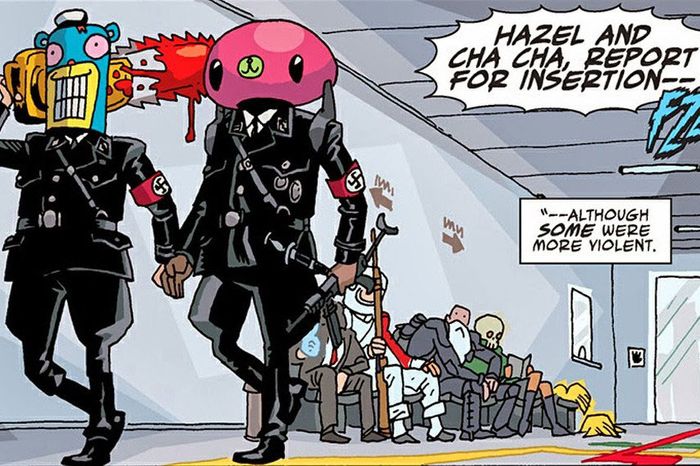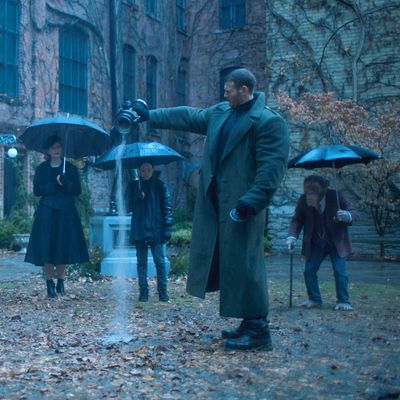
Fans of superheroes, time travel, dysfunctional families, doomsday scenarios, and anything My Chemical Romance-adjacent should take note of The Umbrella Academy, Netflix’s adaptation of the Dark Horse comic book series created by Gerard Way and Gabriel Bá. While the new TV series generally stays in line with the plot of the original series—and, more importantly, its characters and tone—there are a few major differences between the two. If you don’t want the secrets of this particular crime-fighting institution revealed, then beware the spoilers ahead.
Ben (Number Six)
The comics: Right from the get-go, we know Ben Hargreeves (a.k.a. Number Six, a.k.a. The Horror) is dead. We don’t know anything about him, his personality, or how he died. We do get a sense of his powers, seen briefly in flashbacks, as gruesome-looking tentacles erupt from his body to throttle bad guys. Other than that, Ben’s a mystery.
The show: The circumstances of Ben’s death are still unknown, but thanks to Klaus’ ghost-summoning abilities, we see the departed Hargreeves sibling regularly, though he acts more like Klaus’ conscience than an independent character. But that may change in season two: In the season finale, with an assist from Klaus and his augmented powers, Ben physically interacts with the world — and even deploys those tentacles again.
Inspector Lupo/Detective Eudora Patch
The comics: Inspector Lupo is a grumpy old detective with a talking chimp as a partner. He and Diego have a relationship akin to that of Commissioner Gordon and Batman: Diego drops in on the inspector to find out information on his cases, and Lupo begrudgingly helps Diego in his extracurricular vigilante activities.
The show: Inspector Lupo is replaced by Detective Eudora Patch, who has a similar work relationship to Diego. She’s frustrated by his dark superhero act, but she also trusts him and lends her help every once in a while. The biggest addition? Patch and Diego are also exes, a surprising shift from the comics, where Diego, who’s paranoid and self-isolated, is secretly in love with Vanya.
The Commission
The comics: We don’t learn much about the Commission, the organization that employs Five, Hazel, and Cha-Cha. Known in the comics as Temps Aeternalis, it’s an agency that hires individuals with time-traveling abilities to perform “corrections,” or eliminate anyone who might threaten the course of history. In The Umbrella Academy: Dallas, Five is forced to rejoin the Temps Aeternalis, and with the help of Allison, make sure a major historical event goes down as planned.
The show: Not only is the Commission shown in all of its white-collar banality, but it also comes with a head honcho in the form of The Handler, who recruits Five, sends out his kill order when he defects, and then recruits him yet again. Unlike the anonymous collection of goons shown in the comics, there’s a whole chain of command in this agency, from the case workers who figure out ways to correct timelines, to the field workers who travel in time with the help of magical briefcases, to the upper management pulling all the strings.
The Vietnam War
The comics: In The Umbrella Academy: Dallas, Luther, Klaus, and Diego use a dead time-traveler’s corpse to jump back in time and help Five and Allison, who have been coerced into working a mission for Temps Aeternalis. But, because time travel isn’t an exact science (or a science at all, really), they miss their mark and end up in the middle of the Vietnam War. While there, Klaus opens up a bar and even has child—but we don’t learn many details beyond that.
The show: Klaus steals Hazel and Cha-Cha’s suitcase and mistakenly Marty McFlys himself back to 1968, smack dab in the middle of the Vietnam War. He fights for nearly a year and falls in love with a fellow American soldier named Dave, who’s killed in battle. Though the Klaus of the comics seemed mostly unaffected by the war, this Klaus suffers from PTSD and spends the season ravaged by his struggles with addiction and loss.
Orchestra Verdammten/Leonard Peabody
The comics: The action in the comics moves quickly, so it isn’t long after we meet Vanya that we see her being baited into falling for a bad guy’s villainous plan. A masked character known only as The Conductor invites Vanya to join the Orchestra Verdammten, a group of murderous musicians who aim to destroy the world with the help of their “Apocalypse Suite.” We never find out who the musicians are, how they got together, how they came up with Apocalypse Suite, or how they found out about Vanya’s abilities, but after initially brushing them off, Vanya joins them and they change her into the superpowered White Violin.
The show: While Vanya’s transformation into the ultimate baddie occurs very suddenly in the comics, in the show, her change is much more gradual. There’s no death orchestra here, but instead, Vanya is a low-ranking violinist in a real orchestra. Leonard Peabody, a murderous Umbrella Academy fanboy who sneakily insinuates himself into Vanya’s life, takes the place of The Conductor by manipulating Vanya and encouraging her to recognize her powers, harness them, and then seek revenge on her family. Like The Conductor, Leonard is killed as soon as Vanya gets a handle on her powers.
Hazel and Cha-Cha
The comics: Hazel and Cha-Cha, a pair of sociopathic sugar fiends in cartoon masks, don’t appear until the Umbrella Academy stops the White Violin. After numerous Temps Aeternalis gas-maskers try and fail to kill Five, Hazel and Cha-Cha are sent in as the big guns. Their identities are never revealed, and they’re shown to be sadistic but easily distracted. Above all, their strangest character trait is their shared addiction to sugar. (“All we’re interested in is red licorice whips and instant armageddon” says Cha-Cha, as he tortures a character.) The duo investigates a diner where Five murdered agents sent to take him down, and while there, kidnap a waitress named Agnes and the cook, whom they torture for not giving them his pie recipe. They later kidnap and torture Klaus while Agnes serves them pie, but Klaus ultimately uses his psychic powers to kill them both.
The show: Hazel and Cha-Cha aren’t the same sociopathic killers from the comics. They’re contract killers, yes, but they act like disgruntled blue-collar workers fed up by the bureaucratic powers that be. Though this Hazel and Cha-Cha don masks like the ones their characters wear in the comics, they spend more time with their faces revealed, and they don’t quite share their counterparts’ taste for sweets. Hazel loves doughnuts, but he’s more interested in Agnes, the kindly waitress who serves them. He ultimately tries to escape his life as a time-jumping contract killer and run off with Agnes, but Cha-Cha still wants to just get the job done, so they each end up aiming their guns at each other. In the end, Hazel escapes with Agnes to another time — by whom, it’s not clear, and to when and where, we don’t know — while Cha-Cha is swept up in the flames of the apocalypse.
Klaus in the Afterlife
The comics: After being captured and tortured by Hazel and Cha-Cha, Klaus is shot by the killers and goes to heaven. Heaven is, inexplicably, a desert rendered in black and white, and God is cowboy who bares a strange resemblance to Bob Dylan. But even stranger is the fact that God is a politically incorrect cowboy who’s a mite racist and homophobic: He tells Klaus to “stop being such a fairy and kill those two sons o’ bitches” before sending him back to the world of the living to take care of Hazel and Cha-Cha.
The show: Klaus doesn’t die at the hands of Hazel and Cha-Cha but at a rave, after he falls and smacks his head in the middle of a fight. Heaven isn’t a desert but a wooded area, and God isn’t cowboy Bob Dylan but a young girl of color on a bike. This God, like the last one, doesn’t like Klaus, but sends him to speak to his father, Sir Reginald Hargreeves, who reveals that he committed suicide to make sure the Umbrella Academy would reunite and stop the apocalypse.
The Defeat of the White Violin
The comics: In the last issue of The Umbrella Academy: Apocalypse Suite, Luther, Allison, Klaus, and Five go to the Icarus Theater to try to stop Vanya, now the White Violin, from destroying the world with her sonic attack. When the White Violin is distracted, Five shoots her in the head, which doesn’t kill her but leaves her paralyzed. When aftershocks of Vanya’s attack cause a 40,000-ton moonrock to plummet toward them, Klaus surprises everyone by stopping it with his telekinesis. The Umbrella Academy and most of the world survives, but the heroes’ home is destroyed.
The show: As the White Violin prepares to kill Luther, Klaus, Diego, and Five during her performance of ultimate destruction at the Icarus Theatre, Allison sneaks up behind her, gun in hand, and shoots just past her right ear, overwhelming her sonic powers and knocking her out. But the apocalypse is still on: Vanya’s final sonic blast rockets out into space, hitting the moon, and the Umbrella Academy is helpless to stop the giant chunks of moonrock hurtling toward Earth. In the last minutes of the season finale, they join together — with Luther carrying an unconscious Vanya — to jump back in time with Five in the hopes that they can rewrite the future.


